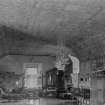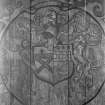Following the launch of trove.scot in February 2025 we are now planning the retiral of some of our webservices. Canmore will be switched off on 24th June 2025. Information about the closure can be found on the HES website: Retiral of HES web services | Historic Environment Scotland
Field Visit
Date 17 September 1925
Event ID 1099050
Category Recording
Type Field Visit
Permalink http://canmore.org.uk/event/1099050
Earlshall.
Earlshall, which stands three-quarters of a mile east of Leuchars village, was in a ruinous state about 1890, but has since then been judiciously and carefully restored. The house forms the northern side and northwest angle of a courtyard, which is now enclosed on the south by a range of outbuilding, on the west by a screen wall, and on the east by a modern balustrade opening to the topiary garden. In the original lay-out of 1546, when Earlshall was built by Sir William Bruce, the western side of the courtyard was occupied by a range of outbuilding which terminated in the little tower, still to be seen at the southwest corner, while on the south and east sides were screen walls. The screen walls were subsequently replaced by the present south range and by a range on the east, which has long since been demolished. It was possibly at that time that the west range of the original lay-out was pulled down, only its outer wall being left to form the present screen.
The entrance to the courtyard, which is still on the west, is protected by a gun-loop on its south side. It is an archway, 5 feet 4 ½ inches wide, heavily splayed at the arris and having a semi-circular head. In the walling above is a panel, now covered by a growth of creeper, which is understood to bear Sir William's coat of arms. Above this again are the remains of a battlement corbelled out in a semi-circular projection above the entrance. To the south of the archway is the little tower already referred to. It is L-shaped on plan, and contains three storeys, the two lower of which are vaulted; its stair gives access to the parapet walk which passes over the entrance. At the north end of the screen wall is the gable of the stair-wing with its five storeys, the uppermost an attic with a dormer window, in the pediment of which are the initials W.B. and A.L. for William Bruce and Agnes Lindsay.
The house consists of a main block, 59 by 27 ½ feet, with a rectangular wing 18 by 19 ½ feet, projecting southwards at its west end; in there-entrant angle is a rounded stair-tower, while at the north-east corner there is a large oval tower, 16 feet in diameter, between which and the east wall of the main block a turret staircase is corbelled out. The main block contains four storeys, the uppermost being a garret, and the stair-tower is sur- mounted by a look-out within a parapet. The masonry throughout is of rubble with freestone dressings. The wall-head cornice returns downward as a sill-course round the upper windows. These windows, being semi - dormers, have pediments, the western bearing within a shield arted per pale: dexter, a saltire and chief, for Bruce; sinister, a fess cheeky between three stars in chief and a hunting horn in base, for Lindsay. Above the shield is a helm with a horse's head for crest. On either side are ‘wodehouses' as supporters. The eastern pediment bears a shield parted per pale: dexter, a saltire and chief; sinister, a fess cheeky between three stars in chief and a hunting hom in base. A third pediment on the north-east tower has the initials W.B. and D.A.L. borne on two hearts intertwined, for William Bruce and Dame Agnes Lindsay. The lowest windows of this tower are dumbbell shaped.
[see RCAHMS 1933 193-197 for a full architectural description]
RCAHMS 1933, visited 17 September 1925.











